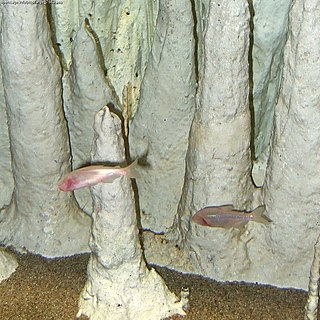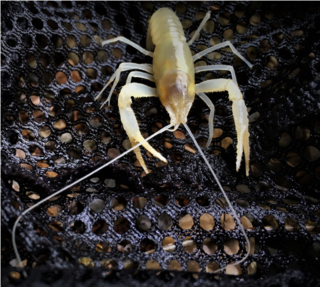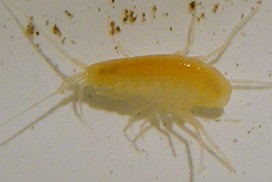Arthropoda
Arachnida
- Kauaʻi cave wolf spider (Adelocosa anops) [7]
- Nelson cave spider (Spelungula cavernicola)
- Calicina cloughensis
- Texella reddelli
- Trogloraptor marchingtoni
- Apochthonius mysterius – Mystery Cave pseudoscorpion
- Apochthonius typhlus – Stone County cave pseudoscorpion
- Hesperochernes occidentalis – guano pseudoscorpion
- Mundochthonius cavernicolus – cavernicolous pseudoscorpion
- Phanetta subterranea – cave spider
- Porrhomma cavernicola – cavernicolous Porrhomma spider
- Porrhomma rosenhaueri – A blind cave Spider (very rare) [8]
- Sinopoda scurion – eyeless huntsman spider
- Aops oncodactylus – Barrow Island cave scorpion
- Troglokhammouanus steineri – Xe Bang Fai cave scorpion
- Vietbocap lao – Nam Lot cave scorpion
- Hormurus polisorum – Christmas Island cave scorpion
- Parobisium yosemite – Yosemite cave pseudoscorpion
- Titanobochica magna – cave pseudoscorpion
- Cicurina madla – Madla Cave meshweaver
- Chinquipellobunus madlae – cave harvestman
- Charinus spelaeus - cave amblypygi
- Stalita taenaria
- Mesostalita nocturna
- Chthonius
- Neobisium maritimum
- Agraecina cristiani - Movile Cave spider
Myriapoda
- Millipedes

Sinocallipus deharvengi
- Causeyella species
- Chaetaspis aleyorum – Aleys' cave millipede
- Chersoiulus sphinx
- Desmoxytes
- Mammamia profuga
- Polydesmus subterraneus
- Sinocallipus
- Titanophyllum spiliarum
- Trichopetalum whitei
- Tingupa pallida
- Zosteractis interminata
- Centipedes
Crustacea
- Crayfish
- Cambarus aculabrum – Benton County cave crayfish
- Cambarus cryptodytes – Dougherty Plain cave crayfish
- Cambarus hamulatus [9] – Prickly cave crayfish
- Cambarus hubrichti – Salem cave crayfish
- Cambarus jonesi [10] – Alabama cave crayfish
- Cambarus laconensis [10] – Lacon Exit cave crayfish
- Cambarus nerterius – Greenbrier cave crayfish
- Cambarus pecki [11] – phantom cave crayfish
- Cambarus setosus – Bristly cave crayfish
- Cambarus speleocoopi [10] – Sweet Home Alabama cave crayfish
- Cambarus subterraneus – Delaware County cave crayfish
- Cambarus tartarus [12] - Oklahoma Cave Crayfish
- Cambarus veitchorum [9] – White Spring cave crayfish
- Cambarus zophonastes – Hell Creek cave crayfish
- Faxonius stygocaneyi – Caney Mountain cave crayfish
- Orconectes australis [13] - Southern cave crayfish
- Orconectes barri [13] - Cumberland Plateau cave crayfish
- Orconectes incomptus [13] - Tennessee cave crayfish
- Orconectes inermis - Northern cave crayfish
- Orconectes inermis inermis - ghost crayfish
- Orconectes inermis testii - unarmed crayfish
- Orconectes packardi [13] - Appalachian cave crayfish
- Orconectes pellucidus - Mammoth Cave crayfish
- Orconectes sheltae [13] - Shelta cave crayfish
- Procambarus acherontis - Orlando cave crayfish
- Procambarus attiguus - Silver Glen Springs cave crayfish
- Procambarus cavernicola - Gabriel cave crayfish
- Procambarus clarkii - Louisiana crayfish (in Portugal and Italy) [14]
- Procambarus delicatus [15] - big-cheeked cave crayfish
- Procambarus erythrops - Santa Fe cave crayfish
- Procambarus franzi - Orange Lake cave crayfish
- Procambarus horsti - Big Blue Spring cave crayfish
- Procambarus leitheuseri - Coastal Lowland cave crayfish
- Procambarus lucifugus - Florida light-fleeing cave crayfish
- Procambarus lucifugus lucifugus - Withlocoochee light-fleeing cave crayfish
- Procambarus lucifugus alachua - Alachua light-fleeing cave crayfish
- Procambarus milleri - Miami cave crayfish
- Procambarus morrisi - Putnam County cave crayfish
- Procambarus niveus - Cuban cave crayfish
- Procambarus orcinus - Woodville Karst cave crayfish
- Troglocambarus maclanei - North Florida Spider Cave Crayfish
- Troglocambarus sp. 1 - Orlando Spider Cave Crayfish
- Others
- Allocrangonyx hubrichti – Hubricht's long-tailed amphipod
- Andhracoides shabuddin – Guthikonda cave isopod
- Andhracoides gebaueri – Belum cave isopod
- Androniscus dentiger – rosy woodlouse
- Alpioniscus strasseri
- Bactrurus brachycaudus – short-tailed groundwater amphipod
- Bactrurus hubrichti – sword-tail cave amphipod
- Bactrurus pseudomucronatus – false sword-tailed cave amphipod
- Barburia yanezi
- Caecidotea antricola – cave isopod
- Caecidotea dimorpha – Missouri cave isopod
- Caecidotea fustis – Fustis cave isopod
- Caecidotea salemensis – Salem cave isopod
- Caecidotea serrata – serrated cave isopod
- Caecidotea stiladactyla – slender-fingered cave isopod
- Caecidotea stygia – stygian cave isopod
- Cancrocaeca
- Cerberusa caeca
- Chaceus caecus
- Cyclops vernalis
- Diacyclops yeatmani – Yeatman's groundwater copepod
- Gammarus acherondytes – Illinois cave amphipod
- Holoped amazonicum
- Lirceus usdagalun – Lee County cave isopod
- Macromaxillocaris [16]
- Munidopsis polymorpha - Blind albino cave crab
- Niphargus species
- Orcovita hickski
- Orcovita orchardorum
- Palaemonias alabamae - Alabama cave shrimp [17]
- Palaemonias ganteri - Kentucky cave shrimp
- Phasmon typhlops
- Samarplax principe
- Spelaeorchestia koloana [7]
- Speocirolana
- Stygiocaris
- Stygobromus barri – Barr's cave amphipod
- Stygobromus clantoni – Clanton's cave amphipod
- Stygobromus heteropodus – Pickle Springs amphipod
- Stygobromus onondagaensis – Onondaga cave amphipod
- Stygobromus ozarkensis – Ozark cave amphipod
- Stygobromus parvus – minute cave amphipod
- Stygobromus subtilis – subtle cave amphipod
- Teretamon spelaeum
- Troglocaris
- Typhlatya
- Typhlocaris [18]
- Typhlocirolana
- Typhlopseudothelphusa
- Villalobosius lopezformenti
- Yucatalana
Insecta
See Cave insects









